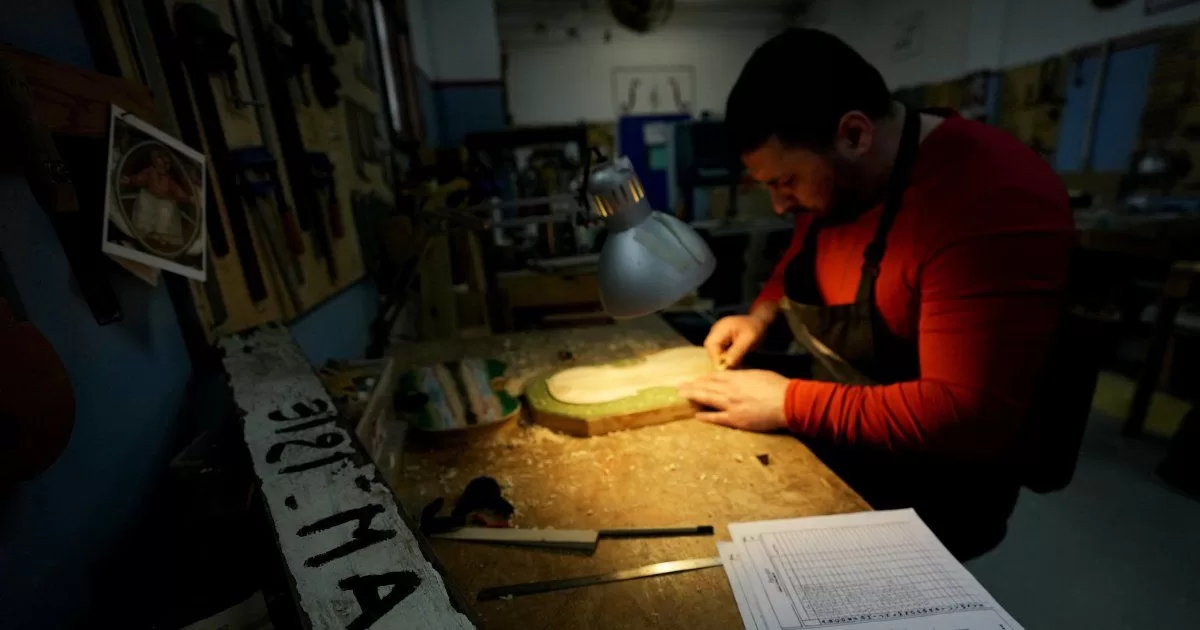The wood that was torn, carved and chiselled to form the instruments was recovered from ruined ships that were used to smuggle immigrants to the shores of Italy; The luthiers who created them are inmates of the largest prison in Italy.
The project, called Metamorphosis, focuses on transforming what might otherwise be discarded into something of value to society: rotten wood into fine instruments, inmates into artisans, all under the principle of rehabilitation.
Two prisoners were granted permission to attend the concert in which 14 prison-made string instruments were used in a program that included works by Bach and Vivaldi. They sat in the royal box next to Mayor Giuseppe Sala.
“I feel like Cinderella,” said Claudio Lamponi, as a friend approached in the lobby before the show with a bow tie to complement his outfit. This morning I woke up in an ugly and dark place. Now I’m here.
Far from the majestic La Scala opera house, the prisoners are in a very different Opera at the Casa di reclusione di Opera, a prison on the southern edge of Milan in the town of Opera, which houses more than 1,400 inmates, including 101 mafia members. detained under a strict regime of almost total isolation.
Permits for inmates to attend La Scala
Some inmates, like Nikolae, who joined Lamponi at La Scala, are given certain permits. Since joining the prison instrument workshop in 2020, Nikolae, who declined to give his full name and prefers not to reveal the charges that landed him in prison a decade ago, has become Opera’s master craftsman, passing from rudimentary instruments made of plywood to harmonious violins worthy of the La Scala stage.
“That’s how I started talking to wood,” Nikolae said recently in the prison workshop, filled with the smell of wood chips between rows of chisels and the faint hum of a saw. I started with very poor materials and they saw that I had good skill.
Working on the instruments for four to five hours a day gives Nikolae a sense of calm to reflect on the mistakes he made and skills that allow him to think about the future. “I’m gaining self-esteem, which is no small feat,” she said.
A graduate of the prison workshops has completed his sentence and works as a master luthier in another prison, in Rome.
I hope that one day I can recover, like this violin, Nikolae said.
Physical and psychological therapy
For another prisoner, who preferred to remain anonymous, making the instruments is a form of therapy, physical and psychological. He lived through two wars in his country of origin and asked not to be identified, since he served a sentence there as a political prisoner and says that he was beaten to the point of needing a crutch to walk.
Fall into a trance as you gently chisel the back of a violin’s front piece, measuring the thickness with an instrument to achieve perfect tone. If they carve too much, they have to start over. His own complicated journey to a new country has given him an understanding of the desperation that led migrants to embark on unseaworthy ships.
“As I work on these pieces, I think about the refugees this wood transported, the women and children,” he said. I just think about that while I work, about what this piece of wood has experienced.
Lamponi and prisoner Andrea Volonghi have found new purpose in their life sentences, dismantling smugglers’ canisters stored in a courtyard between the prison blocks. Originally, the boats were transformed into crucifixes and nativity scenes, but the inmates who were already trained luthiers thought: why not musical instruments?
So now they look for the parts for the workshop, removing the rusty nails in the process. They send the most damaged wood to another prison in Rome, where prisoners make crucifixes for rosaries. The rosaries are finally assembled by migrants in a Vatican workshop.
400 hours to create an instrument
The boats arrive at the Opera prison when they are seized, still carrying vestiges of the migrants, and with them a reminder of the 22,870 people who, according to the UN, have died or disappeared since 2014 on their dangerous journey through the Mediterranean.
A bag with a disposable diaper, a baby bottle, and baby shoes rests on a bow next to cans of anchovies and Tunisian tuna and many plastic sandals, including a small white and pink girl’s tennis shoe with a familiar Western logo.
We don’t know what happened to them, but we hope they survived, Volonghi said.
Each instrument takes 400 hours to create, from disassembling the ships to the finished product. Classical violins made in the famous workshops of Cremona, an hour’s drive from Milan, use spruce and maple, while the instruments of the sea are assembled from a softer African spruce, with shades of blue, orange and red bathed. for the sun and the sea that remain as a reminder of the trip. The paint that preserves the wood influences the tone of the instruments.
These instruments, which have crossed the sea, have a sweetness that you cannot imagine, said cellist Mario Brunello, a member of the Orchestra of the Sea. They do not have a story to tell. They have hope, a future.
FUENTE: AP


